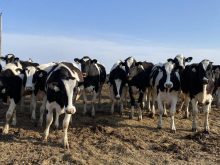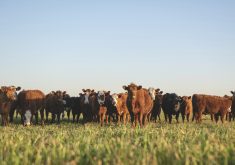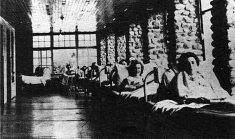Hunters are playing a significant role in the effort to eradicate bovine tuberculosis (TB) in the Riding Mountain area of southwestern Manitoba.
By turning in samples of elk and white-tailed deer, they are helping wildlife managers determine where the disease is present, and more importantly, they are helping define where the disease is not.
Since 1992, bovine TB has been found in wild, free-ranging elk and deer in and around Riding Mountain National Park (RMNP), as well as in a small number of domestic cattle herds in the area. The disease management measures have restricted bovine TB infections to the Birdtail Valley area in RMNP and adjacent areas of the R. M. s of Grandview and Rossburn.
Read Also

Pig transport stress costs pork sector
Popular livestock trailer designs also increase pig stress during transportation, hitting at meat quality, animal welfare and farm profit, Agriculture and Agri-Food Canada researcher says
Hunters have had an important role to play in halting the spread of TB. Their participation in the surveillance program has resulted in data that was used to help pinpoint the “Hot Zone” or Core Area of TB infection.
MORE EVIDENCE
Every time a TB-positive animal is discovered in places where they expect the disease to be, researchers gather more evidence that TB is now contained within a clearly defined Core Area. This allows them to focus more resources on a smaller, more manageable geographic region.
Ken Kingdon, co-ordinator for the wildlife health program, said hunters help remove older bulls and bucks, which pose the greatest threat of disease transmission, from the herds.
Since 1998, hunters have submitted well over 2,500 elk and 5,000 white-tailed deer samples. Ideally, a quality sample is one that has not been frozen and includes the head and lungs of the animal.
Of the samples from the 2008-09 hunting season, one buck was confirmed to be TB positive. So far this year, one hunter-killed bull elk has been found to have TB. Both of these animals were shot in the TB Control Zone in Game Hunting Area (GHA) 23A. In addition, three animals inside RMNP were found to be TB positive through the park’s monitoring program. They were euthanized and removed.
Incentives for hunters
“It’s impor tant to know where the animal came from,” says Dick Gawiuk, an Elphinstone-area hunter and member of the Little Saskatchewan River Game and Fish Association who has submitted samples in the past. “The location of the kill has to be accurate. If disease turns up in a sample, then that is where efforts are going to be concentrated.”
Hunters who turn in quality samples from GHA 23 and 23A receive a “Wildlife Co-operators” ball cap courtesy of Manitoba Conservation and an extra white-tailed deer tag that can used for hunting west of Highway 10.
“It’s not always convenient to take the sample in after a long day in the field,” explains Gawiuk. “But it’s still important to bring that sample in. It helps with the surveillance program and it’s good for the sport.”
DISEASE AFFECTS ANIMALS UNDER STRESS
If a hunter kills a visibly infected animal, it should be taken to a Manitoba Conservation or Parks Canada lab for analysis and the meat should not be eaten. Fortunately, the risk of transmission to humans is very low even for a hunter who field dresses a TB-positive animal. Simple hygiene practices will keep him or her safe.
HOW TB AFFECTS THE CATTLE INDUSTRY
The real threat of bovine TB is to the cattle industry. Manitoba lost its bovine TB-free status in 2003 following the discovery of infected cattle herds in the Riding Mountain region. Fortunately, in 2006, TB-free status was reinstated thanks to a comprehensive cattletesting program by the Canadian Food Inspection Agency (CFIA) and the cooperation of local livestock producers, as well as the concerted disease management efforts of other agencies such as Parks Canada; Manitoba Conservation; and Manitoba Agriculture, Food and Rural Initiatives (MAFRI).
For individual cattle producers, this has meant disruptions, inconvenience, and added costs because regular TB testing has become a requirement in order to market cattle. And, for the unfortunate farmers whose herds have tested positive, this results in a total depopulation of all of their livestock, not just cattle, and possibly even their family pets. Producers receive financial compensation for their losses but nothing can replace the years of selective breeding that goes into building up a productive herd. The shock of watching your entire life’s work disappear is devastating.
“Hunters want to keep the elk and deer herds healthy, but part of the motivation to participate in the surveillance program is to help out the producers,” says Gawiuk.
Stopping the spread
Through changes in hunting seasons and bag limits established by Manitoba Conservation, hunters have helped reduce the elk population to approximately half of its historic high of 5,000 animals in the Riding Mountain area. Manitoba Conservation and Parks Canada have now agreed to stabilize the elk herd population at present levels with Parks Canada to conduct further rigorous removals in the Core Area.
Disease surveillance will still be required for the foreseeable future to ensure that TB is not spreading out of the Control Zone, and to keep trade restrictions on cattle from being implemented once again. But the good news is that TB is on the retreat thanks to the collective efforts of stakeholders and government agencies.


















